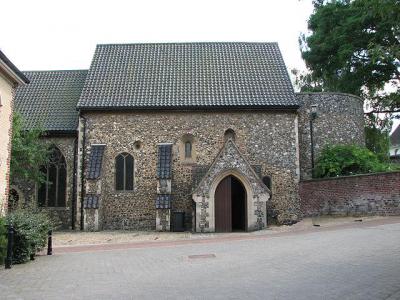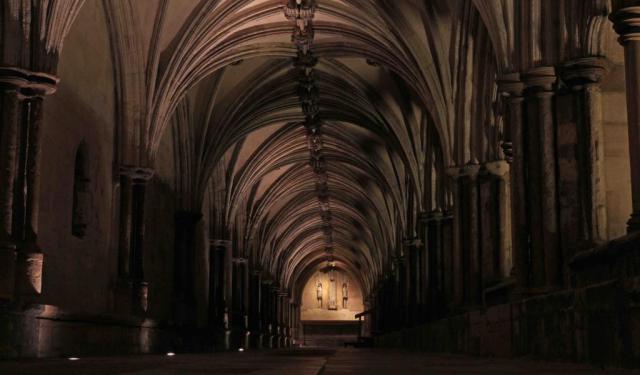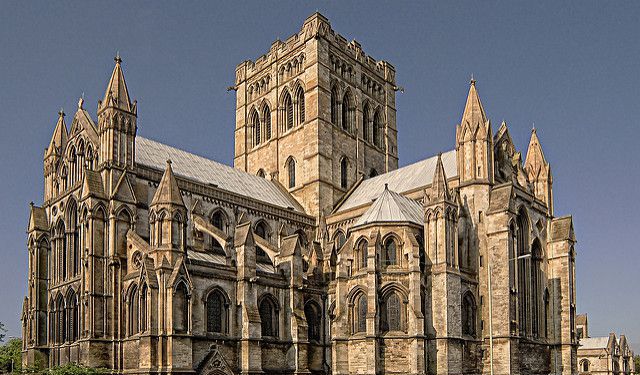
St Julian's Church, Norwich
St Julian's Church was built in the 11th and 12th century. It is an early round-tower church, one of the 31 surviving parish churches of a total of 58 that were built in Norwich after the Norman conquest of England.
Julian of Norwich, a 14th-century anchoress, took her name from the saint of the church, which was dedicated either to Julian the Hospitaller or Julian of Le Mans. Her anchoress's cell was in a corner of the churchyard. The church was attached to the priory at Carrow Abbey and the prioress and nuns appointed the priest and maintained the church. It is speculated that the Prioress Edith Wilton and her provided the anchoress with her writing materials.
Julian of Norwich's cell did not stand empty. In 1428 Julian(a) Lampet moved in the cell and she was there for fifty years during which time Margaret Pygot was the prioress.
By 1845 St. Julian's was in a very poor state of repair and that year the east wall collapsed. After an appeal for funds, the church underwent a ruthless restoration. It was further restored in the 20th century, but was destroyed during the Norwich Blitz of 1942, when in June that year the tower received a direct hit. After the war, funds were raised to rebuild the church by the architect A. J. Chaplin, and it reopened in 1953, mainly to act as a Shrine Church for Julian of Norwich.
It now appears largely as it was before its destruction, although its tower is much-reduced in height, and a chapel has been built in place of the long-lost anchorite cell. The flint building has stone and brick dressings with a pantile roof. It consists of a nave, single-bay chancel, a south chapel with vestry with a circular west tower. The tower includes a bell from around 1500 which was rehung in 1992.
The church has an organ dating to 1860 by Henry Jones, which was installed here in 1966. A specification of the organ can be found on the National Pipe Organ Register.
The Friends of Julian have a shop and lending library in a hall at the corner of the street.
Julian of Norwich, a 14th-century anchoress, took her name from the saint of the church, which was dedicated either to Julian the Hospitaller or Julian of Le Mans. Her anchoress's cell was in a corner of the churchyard. The church was attached to the priory at Carrow Abbey and the prioress and nuns appointed the priest and maintained the church. It is speculated that the Prioress Edith Wilton and her provided the anchoress with her writing materials.
Julian of Norwich's cell did not stand empty. In 1428 Julian(a) Lampet moved in the cell and she was there for fifty years during which time Margaret Pygot was the prioress.
By 1845 St. Julian's was in a very poor state of repair and that year the east wall collapsed. After an appeal for funds, the church underwent a ruthless restoration. It was further restored in the 20th century, but was destroyed during the Norwich Blitz of 1942, when in June that year the tower received a direct hit. After the war, funds were raised to rebuild the church by the architect A. J. Chaplin, and it reopened in 1953, mainly to act as a Shrine Church for Julian of Norwich.
It now appears largely as it was before its destruction, although its tower is much-reduced in height, and a chapel has been built in place of the long-lost anchorite cell. The flint building has stone and brick dressings with a pantile roof. It consists of a nave, single-bay chancel, a south chapel with vestry with a circular west tower. The tower includes a bell from around 1500 which was rehung in 1992.
The church has an organ dating to 1860 by Henry Jones, which was installed here in 1966. A specification of the organ can be found on the National Pipe Organ Register.
The Friends of Julian have a shop and lending library in a hall at the corner of the street.
Sight description based on Wikipedia.
Want to visit this sight? Check out these Self-Guided Walking Tours in Norwich. Alternatively, you can download the mobile app "GPSmyCity: Walks in 1K+ Cities" from Apple App Store or Google Play Store. The app turns your mobile device to a personal tour guide and it works offline, so no data plan is needed when traveling abroad.
St Julian's Church on Map
Sight Name: St Julian's Church
Sight Location: Norwich, England (See walking tours in Norwich)
Sight Type: Religious
Sight Location: Norwich, England (See walking tours in Norwich)
Sight Type: Religious
Walking Tours in Norwich, England
Create Your Own Walk in Norwich
Creating your own self-guided walk in Norwich is easy and fun. Choose the city attractions that you want to see and a walk route map will be created just for you. You can even set your hotel as the start point of the walk.
Norwich's Haunted Buildings
The long and sometimes bloody history of Norwich has left its mark on the city in the form of spooky happenings. Indeed, nearly half of the local population have reported experiencing throughout their life something paranormal. Add to this a mildly alarming number of UFOs spotted on the outskirts of Norwich, and you get one of, if not the most haunted area in the UK.
Needless to say that in a... view more
Tour Duration: 1 Hour(s)
Travel Distance: 1.4 Km or 0.9 Miles
Needless to say that in a... view more
Tour Duration: 1 Hour(s)
Travel Distance: 1.4 Km or 0.9 Miles
Norwich Introduction Walking Tour
The Iceni tribe predated the Romans in the village of Caistor, near the area of present-day Norwich. In 60 AD an uprising led by Boudica had been put down and Caistor became the Roman capital of East Anglia. Anglo-Saxons settled the town of Northwic in the 4th century. By the 10th century Northwic became Norwich, a prosperous trading center.
William the Conqueror arrived with a bang in 1066.... view more
Tour Duration: 2 Hour(s)
Travel Distance: 2.5 Km or 1.6 Miles
William the Conqueror arrived with a bang in 1066.... view more
Tour Duration: 2 Hour(s)
Travel Distance: 2.5 Km or 1.6 Miles


